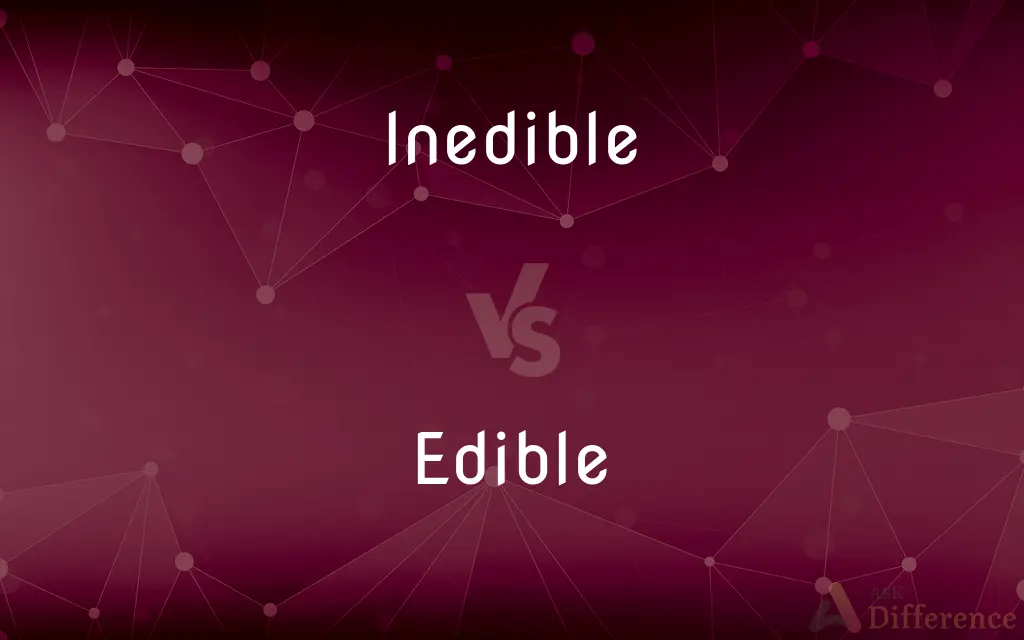Inedible vs. Edible — What's the Difference?
By Tayyaba Rehman & Fiza Rafique — Updated on March 19, 2024
Edible items are safe and suitable for consumption, while inedible ones cannot be eaten due to being harmful, toxic, or not digestible.

Difference Between Inedible and Edible
Table of Contents
ADVERTISEMENT
Key Differences
Edible substances are those that can be consumed by humans without causing harm, including foods that are part of a typical diet. In contrast, inedible substances include items that are toxic, non-nutritious, or otherwise harmful if consumed, such as certain plants, chemicals, and objects.
While edible items are prepared and processed in ways that make them safe and enjoyable to eat, inedible items may be found in nature or be man-made products not intended for consumption. For instance, while apples are edible, providing nutritional value, the seeds contain cyanide compounds and are considered inedible in large quantities.
Edible substances often undergo safety regulations and quality control to ensure they are fit for human consumption. On the other hand, inedible items, being unfit for consumption, are not subject to these food safety standards.
The distinction between edible and inedible can also depend on cultural practices and individual dietary restrictions. What is considered edible in one culture may be deemed inedible in another due to taste preferences, dietary laws, or health considerations.
Edible items are essential for human survival, providing the necessary nutrients for health and well-being. In contrast, ingesting inedible substances can lead to health complications, including poisoning, digestive blockages, and allergic reactions, emphasizing the importance of distinguishing between the two.
ADVERTISEMENT
Comparison Chart
Definition
Harmful, toxic, or not digestible
Safe and suitable for consumption
Examples
Plastic, certain plants, chemicals
Fruits, vegetables, meat
Safety Regulations
Not applicable
Subject to food safety standards
Cultural Dependence
Consistently recognized as harmful
Varies by culture and dietary laws
Health Impact
Can cause health complications
Provides nutrients, essential for health
Compare with Definitions
Inedible
Not digestible by humans.
Plastic bags are an example of inedible waste.
Edible
Can be eaten without harm.
The mushrooms found in the forest were edible.
Inedible
Often toxic or poisonous.
The brightly colored frog is inedible due to its toxins.
Edible
Varied by cultural preferences.
Insects are considered edible in many cultures.
Inedible
Harmful if eaten.
Some household cleaners contain inedible substances.
Edible
Included in the human diet.
Rice is an edible grain consumed worldwide.
Inedible
Not fit for consumption.
The berries were beautiful but inedible.
Edible
Subject to food safety standards.
Edible products are inspected for contaminants.
Inedible
Not subject to food regulations.
Inedible products are not inspected by food safety agencies.
Edible
Safe for human consumption.
Carrots are an edible root vegetable.
Inedible
Not fit or suitable for eating
An inedible variety of mushroom
Edible
Fit to be eaten (often used to contrast with unpalatable or poisonous varieties)
The shrub has small edible berries
Inedible
Unfit to be eaten; not edible.
Edible
Items of food
Delicatessen, as the name suggests, means delicate edibles
Inedible
Not edible; not appropriate, worthy, or safe to eat
Edible
Fit to be eaten, especially by humans
Edible roots.
An edible mushroom.
Inedible
Anything inedible; that which is not a foodstuff.
Edible
Something fit to be eaten; food
Edibles such as vegetables and meat.
Inedible
Not edible; not fit for use as food.
Edible
Capable of being eaten without harm; suitable for consumption; innocuous to humans.
Edible fruit
Inedible
Not suitable for food
Edible
Capable of being eaten without disgust.
Although stale, the bread was edible.
Edible
In which edible plants are grown for human consumption.
Edible
Anything edible.
Edible
In particular, an edible mushroom.
Edible
(marijuana) a foodstuff, usually a baked good, infused with tetrahydrocannabinol from cannabutter etc.
Edible
Fit to be eaten as food; eatable; esculent; as, edible fishes.
Edible
Any substance that can be used as food
Edible
Suitable for use as food
Common Curiosities
Why are some plants inedible?
Some plants are inedible due to toxins that can cause harm or death if consumed.
Do cultural differences affect what is considered edible?
Absolutely, cultural practices and dietary restrictions significantly influence what is considered edible.
What are common examples of inedible substances found at home?
Cleaning products, cosmetics, and certain decorative plants are common inedible items.
What should I do if I ingest something inedible?
Seek immediate medical attention, especially if you experience discomfort or poisoning symptoms.
Can inedible items ever become edible?
Certain inedible items can become edible through processing or cooking methods that remove toxins or make them digestible.
Is it possible for something to be edible to one species but inedible to humans?
Yes, many substances that are edible to animals or insects are inedible or toxic to humans.
How can I tell if something is edible or inedible?
It's best to refer to reliable sources or experts, like food safety guidelines or botanists, when in doubt.
Are all natural items edible?
Not all natural items are edible; many plants, mushrooms, and animals can be toxic.
Can cooking make inedible items edible?
Cooking can detoxify some inedible items, but not all toxic substances are neutralized by heat.
Are there legal implications for selling inedible items as food?
Yes, selling inedible items as edible food can lead to legal consequences, including fines and recalls.
What makes something edible?
Something is edible if it is safe for human consumption and can provide nutritional value.
How is edibility determined for new food products?
New food products undergo rigorous testing for toxicity, nutritional value, and safety before being deemed edible.
Why are some inedible items mistaken for edible ones?
Lack of knowledge or confusion with similar-looking edible items can lead to mistakes.
What role do toxins play in determining edibility?
Toxins are a primary factor; their presence in high enough concentrations makes a substance inedible.
How does food safety regulation differ between edible and inedible products?
Food safety regulations apply to edible products to ensure they are safe for consumption, while inedible products are not subject to these standards.
Share Your Discovery

Previous Comparison
Humble vs. Humility
Next Comparison
Feral vs. WildAuthor Spotlight
Written by
Tayyaba RehmanTayyaba Rehman is a distinguished writer, currently serving as a primary contributor to askdifference.com. As a researcher in semantics and etymology, Tayyaba's passion for the complexity of languages and their distinctions has found a perfect home on the platform. Tayyaba delves into the intricacies of language, distinguishing between commonly confused words and phrases, thereby providing clarity for readers worldwide.
Co-written by
Fiza RafiqueFiza Rafique is a skilled content writer at AskDifference.com, where she meticulously refines and enhances written pieces. Drawing from her vast editorial expertise, Fiza ensures clarity, accuracy, and precision in every article. Passionate about language, she continually seeks to elevate the quality of content for readers worldwide.













































